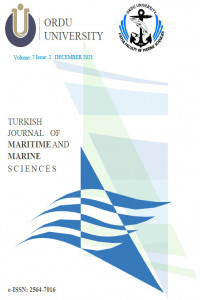Navlun Oranlarının Korsan Saldırılarına Etkisi
Bu çalışmanın amacı kuru dökme ve tanker piyasalarındaki navlun seviyelerinin korsan saldırılarına etkisinin olup olmadığının tespit edilmesidir. Çalışmadaki örneklem 2008 ve 2018 dönemleri arasını kapsayan aylık dökme ve tanker navlun endekslerinden ve yıllık korsan saldırısı değerlerinden oluşmaktadır. Korsan saldırısı değişkeni analizleri daha isabetli şekilde yürütebilmek için kübik dönüşüm ile aylık veriye dönüştürülmüştür. Sonuçlar navlun oranlarının korsan saldırılarının nedeni olduğunu, navlun seviyelerindeki değişmelerin hem dökme gemilerinde hem de tanker gemilerindeki korsan saldırılarını anlamlı bir şekilde pozitif yönde etkilediğini ve dökme piyasasındaki navlun değişimlerinin korsan saldırılarını daha fazla açıkladığını göstermektedir. Bu sonuçlar, artan navlun gelirlerinin korsanları saldırmaları için daha fazla motive ettiğine işaret etmektedir.
Anahtar Kelimeler:
Korsan saldırısı, Navlun oranı, Tanker taşımacılığı, kuru yük taşımacılığı
The Impact of Freight Rates on Pirate Attacks
The aim of this study is to determine whether freight levels in dry bulk and tanker markets have an impact on pirate attacks. The sample included in the study consists of monthly bulk and tanker freight indices and annual attack values between 2008 and 2018 periods. Annual attack values due to data constraint have been converted to monthly data by cubic transformation in order to carry out the analyzes more accurately. The results reveal that freight rates are the causes of pirate attacks, freight rates significantly affect pirate attacks on both bulk ships and tanker ships in a positive way, and freight rate changes in the bulk market explain the attacks more. This results indicate that increased freight revenues are more motivating for pirates to attack.
Keywords:
Pirate attacks, Freight rate, Tanker shipping, Dry bulk shipping,
___
- Allen, M. P. (2004). Understanding Regression Analysis, New York, Springer Science & Business Media.
- Archdeacon, T. J. (1994). Correlation and Regression Analysis: A Historian's Guide, Univ of Wisconsin Press.
- Chatterjee, S., Hadi, A. S. (2015). Regression Analysis by Example, John Wiley & Sons.
- Dickey, D. A., Fuller, W. A. (1979). Distribution of the estimators for autoregressive time series with a unit root. Journal of The American Statistical Association, 74(366a): 427-431.
- Dura, Y. C., Beser, M. K., Acaroglu, H. (2017). Econometric analysis of Turkey's export-led growth. Ege Akademik Bakis, 17(2): 295.
- Esquerdo, P. J. R., Welc, J. (2018). Applied Regression Analysis for Business, Switzerland, Springer International Publishing
- Gordon, R. (2015). Regression Analysis for the Social Sciences, New York, Routledge
- Granger, C.W.J. (1969) Investigating causal relations by econometric models and cross-spectral methods. Econometrica, 36: 424-438.
- Hallwood, C., Miceli, T. (2015). Maritime Piracy and Its Control: An Economic Analysis, New York, Springer.
- ICC (2019). Piracy and Armed Robbery against Ships Report, obtained from https://www.icc-ccs.org/reports/2019Q2IMB-Piracy-Report.pdf.
- Investing (2019). Baltic Dry Index and Baltic Dirty Tanker Index, obtained from https://tr.investing.com/.
- Mejia, M. Q., Kojima, C., Sawyer, M. (2013). The Malmö Declaration: Calling for a multi-sectoral response to piracy. In “Piracy at Sea”, Springer, pp. 1-15, Berlin, Heidelberg.
- Menard, S. (2002). Applied Logistic Regression Analysis (Vol. 106), Sage.
- Murphy, M. N. (2013). Contemporary Piracy and Maritime Terrorism: The Threat to International Security, New York, Routledge.
- Pagan, A. R., Hall, A.D. (1983). Diagnostic tests as residual analysis. Econometric Reviews, 2(2): 159-218.
- Yu, L., Li, J., Tang, L., Wang, S. (2015). Linear and nonlinear Granger causality investigation between carbon market and crude oil market: A multi-scale approach, Energy Economics, 51: 300-311.
- Başlangıç: 2015
- Yayıncı: ORDU ÜNİVERSİTESİ > FATSA DENİZ BİLİMLERİ FAKÜLTESİ
Sayıdaki Diğer Makaleler
Konteyner Taşımacılığında Nakliye Müteahhitlerinin Hat Seçim Kriterlerinin Değerlendirilmesi
Çetin POLAT, Fahriye MERDİVENCİ
Navlun Oranlarının Korsan Saldırılarına Etkisi
Kadir Emrah ERGİNER, Abdullah AÇIK, Özgür YILDIZ
Güllük Körfezi’nde (Ege Denizi) Lesepsiyen Hemiramphus far (Hemiramphidae)’ın Bulunuşu
Hydrographic study of Shatt Al-Arab estuary in the context of climate change
Batı Karadeniz’de (Sinop İli) Endüstriyel Balıkçılıkta Kullanılan Ağlar ve Teknik Özellikleri
Yakup Erdem, Süleyman Özdemir, Uğur ÖZSANDIKÇI, Ferhat BÜYÜKDEVECİ
